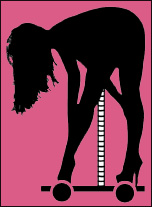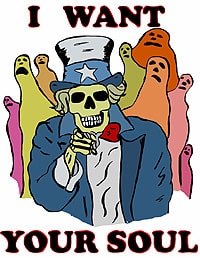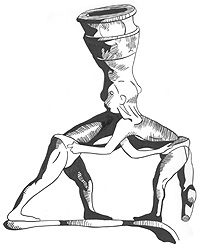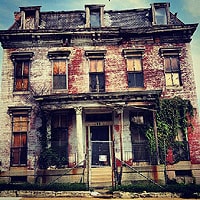“There is no safe place. Wherever you go crime will follow. They’ll come for you regardless, so you might as well fight where you’re at. I lived here my whole life and I’m not letting some druggies drive me out.”
-Martha
Rolling the Mass Transit Dice
Last night I was tired, feeling old, and it was really cold. I have three practical options for getting to work, all taking about the same amount of time: take one bus and walk a mile; two buses through the ghetto; three buses through the rarified county. As I got to my first stop after my mile long walk from my humble ghetto abode, I saw the bus coming that would begin my three shuttles of ease. But wait, I had actually had a date this weekend and bought a lady some drinks, so I was broke and only had $15 to last until Friday PM, and it was only Monday night.
I decided to bank that $1.70 and walk the last mile and a quarter to work. I neared work, wondering if I was going to spend my savings on oatmeal cream pies or something with antioxidants… Just then I looked up to see if I had miscalculated. If the third bus that might have served me for option three was on time then it should be hurdling back down toward the ghetto now, and it was nowhere to be seen. I had made the timely call. Little did I know, that I might have made the luckiest call of my life.
I made it to work, bought a bottle of water, and checked the dates on Mister John’s yogurt case. Then a coworker came up to me, “Do you hear those shots out there?”
As cops and crime lab people filed through my section to use the bathroom in the warehouse over the next six hours I got snippets of information. I also took my break out front and watched the cops with dogs and flashlights searching the grass behind the bus stop, for, I supposed, shell casings. When morning came I walked the area where the three people were gunned down and found only some stains. The County cops did a better job of cleaning up their crime scene than the City cops usually do.
The Question of Urban Flight
Come morning I decided on the single bus trip again and walked the route to the major transfer point. When I arrived and stood off from the stop, away from the crowd, I got the usual suspicious looks from the other patrons, and got passed by a cop cruiser twice, as the second cop in the passenger seat checked me out. I have found that the sprinkling of criminal bus patrons at a stop will not mess with me when I stand off. However, this does result in me being questioned, and sometimes detained, by cops about once a year. It then occurred to me then that the dead man, the other man that was flown out in real bad shape, and the wounded girl from up the street might have been gunned down at that bus stop by someone who had been ‘standing off’.
This got me thinking of the changing crimescape of Baltimore, as more and more of the violence is exported into the adjacent areas of Baltimore County. It also had me reexamine the mechanics of what used to be erroneously termed ‘white flight’ in the 1980s, but was really urban flight, as any family, black or white, that could afford to, fled to the county to escape the ghetto hood-rats that terrorized city neighborhoods.
I considered the plight of the working class people who had fled to this neighborhood, eight miles north of the city line, over rolling hills and across rivers, to escape the ghetto; the ghetto that then spewed forth its hood-rats to pursue them into their suburban enclave like the outriders of some victorious urban army hounding the survivors of some beaten host. Most of my coworkers live in the area, and were bemoaning the fact that one now had to move out of state to be safe. As I drank my tea and watched the collection of what I surmised to be spent shell casings I was approached by three young ladies questioning me. I had not much to offer. They thanked me and the middle girl said, “This is why my dad made me move out of Baltimore, and now its here—out here.”
In large measure she encapsulated the social mechanics. Where I live, in Northeast Baltimore, was, five years ago, a war zone, where homeless criminals used your backyard for a latrine and gangs of teens ran you down on the street to take what you had. Now, that plague, like an advancing tide of locusts, has passed us by, and the County cops up the street are fighting more desperately to hold their territory than the City cops down here.
How would I advise this lady or my coworkers, in the manner of urban flight and pursuit?
A Case Study in Urban Flight
I was in their shoes twelve years ago, when my neighborhood had become a hunting preserve for stickup boys and muggers. [See When You’re Food] My house’s value had plummeted and I could not sell, not even at a loss that would have put me further into debt. The best offer for my house had been from a drug treatment group that would have required me to pay them $5,000 to take over my house; $5,000 that I would have had to borrow, somehow, after filing for bankruptcy and having my wife and son’s cars repossessed. This all stemmed from a crippling injury that had put me out of work for seven months in the mid nineties.
My oldest son had escaped the ghetto and was out of town after a harrowing ordeal in Baltimore City schools. My youngest son, an exceptionally bright student, was about to enter middle-school and be devoured by the same educational institution/penal colony. I would not send another one of my children into a school where gangs of thugs hung out the windows and threatened to kill me as I walked by on my way home from work.
It was time to escape, but how?
At the time 1,000 homeowners per month were fleeing Baltimore City. So rent was pretty steep in the county. Any two bedroom apartment or townhome I rented would cost more than my mortgage. However, if I could get into one of these my son would be in a school that was not a Darwinian experiment. Also, my wife would be in an area where she could safely walk to a job, increasing our joint income. When she had lost her car she found herself on foot being attacked by groups of men and women and had barricaded herself in the house. For her, she was looking at the move as an escape from prison.
Also, since I still worked in the city, I would continue my nocturnal visits, resulting in me continuing to be threatened and attacked with regularity. In this way, my new pursuit—the study of violence—would not be hampered. This was a win-win. I just had to find a way to get my non-combatants out of the war zone.
I did some research and found out that mortgage companies would let your PMI run out before they foreclosed, and that this insurance was paid up front at the beginning of my purchase year. I had ten months. I stopped making payments and banked the money for a security deposit, first month’s rent, and moving van, which equaled four months worth of mortgage payments. As soon as we had the money we would move; but where to?
There were only two Baltimore County areas I could afford to rent in: Essex [the area where the three people were gunned down last night] and Dundalk. I had lived and worked and fought in each of these locales. The choice was before me. What was the nature of the equation I used to assure my son a good education [he is now at the top of his class in a prestigious university], my wife a porch she could actually sit on, and her dog a yard from which she would not be snatched to be used as bait for pit-bulls?
Now, Essex and Dundalk were both renowned centers of white alcoholism and drug use. Both of these areas, I knew, would soon be targeted by the black ghetto drug gangs, as distribution centers for their products. You see, in the 1980s, white boys from these areas drove into the city to buy drugs. Their sons were made of softer stuff, and preferred to stay at home and play video games when they got high—so the drugs would be brought to them, along with the related violent crime.
The social dynamic in white suburbia—I had known since the 1970s—revolves around the fact that white girls love nothing more than getting high. Since they are not risk takers, they have sex with boys in return for drugs. The involvement of most boys with drugs in suburbia begins as a means to get laid. This is why I did not date in high school. While my friends were getting girls high so that they could have sex I trained and read, and did yard work for that neglected forty-year-old lady down the street…
If you want to look at social mechanisms—particularly where crime and violence and altered states of consciousness are concerned—look no farther than the primal need of young men to be accepted by young women. In fact, Shaka Zulu, one of the most innovative military genius’ of all time, based his entire force structure on limiting sexual access to females until the young men of his age-based regiments had proven themselves in battle.
I chose Dundalk over Essex, when everyone else in Baltimore was choosing Essex and more upscale areas like it. Dundalk has long been derided as the home of rednecks and idiots, and has a huge drug problem. [I concurred, knowing it to be the home of rednecks and idiots.] However, Dundalk has remained not only safer than Essex, but safer than some high-end surburban enclaves on the north and west approaches of the city that are carved deep into the countryside. I have a dotcom friend who was actually surprised when his high-end enclave was invaded by hood-rats. He and those like him, who had lobbied for light rail servicing their neighborhood and downtown Baltimore, so that they could see the Orioles and the Ravens play, without having to worry about driving drunk, did not understand that mass transit is a two-way proposition.
Dundalk is safer than Essex for the following reasons.
Dundalk is only ‘penetrated’ by one bus line, the #4, which runs only once an hour and is a country-to-county line. It is peripherally served by two lines, the #10 [which ends downtown, in a business district] and the #20 [a bad line that goes across town to the West Baltimore ghetto]. In areas served by all three of these lines, crime is much higher than where it is served by only the #4. Dundalk is also a peninsula, with very limited egress and access for pedestrians. It is easy for cops to bottle up when they are doing a manhunt. I moved my family to a part of Dundalk served only by the #4, and situated on a spit of land surrounded by water on three sides. I knew, that the more inconvenient it would be for me to get to and from work, the safer they would be at home and at school. It took me a two-to-three hour walk/commute to get to my job in the city. No hood-rat would spend that kind of effort getting into my neighborhood.
Essex, on the other hand, was penetrated by the #4, #55, #24, and #23 [the second worst of 64 lines in Baltimore] and had three major transfer points. Essex is also not a peninsula and is bisected by Route #40, which is a major narcotics trafficking artery linking D.C. and Baltimore with Philadelphia and New York. Even though Route #40 does not have good bus service, there is a motel every two miles and many cabbies reside in these locations. If you are an industrious hood-rat wanting to move drugs upstate, you do not even need a car to set up shop in Essex and beyond.
Identifying the Toxic Drug Culture
So, you want to flee your city, and do not want to end up like some poor sap who flees Detroit only to end up in Flint.
I am assuming that you are not wealthy. If you are wealthy you can buy your way into the safest enclave. Just make certain it has no mass transit service. I am a mass transit user, and I can tell you that most of my fellow commuters are decent people. However, I would make a ballpark estimate that 25% of mass transit users use mass transit because they use drugs and drink alcohol to excess. Also, the males most likely to commit violent crimes will be dependent on mass transit, due largely to their age and the extent of parental neglect.
Drug use among teens will be at epidemic proportions in every neighborhood in the U.S. That is normal. Americans are dope fiends; ask the Columbians. The best signs that drug consumption has reached backfire proportions, where it will render the area uninhabitable, are listed below. The following are clues that you can glean from your car as you cruise a neighborhood.
- Loan adult male pedestrians [bus patrons] are the first clue that a neighborhood is going down the rabbit hole of the drug pandemic. Cars are the modern American male’s chariot, his ego engine. If this man has decided not to drive it is either because he is not permitted by the authorities because off drunk driving convictions, or because he is spending all of his money on dope, probably living in Mom’s basement. The more of these losers you see, the worse the drug problem is, and the more advanced it is, as evidenced by their age.
- Just like every normal American boy wants to cruise in a vehicle, normal girls want to be driven around like a princess in her chariot. If you see young women walking alone, walking with more than one young man, or walking with men of a different racial group, than that is a clear indication that they are trading sex for drugs. Now, this is what teenage girls do all over America, and have since I was a boy. However, decent teenage girls have sex for drugs in the backseat of a car, or behind the tailgate of a pickup truck whose owner has spirited them to a secluded place. Drug-whores do it behind the dollar store.
The Sexist/Racist Question
I will be charged with racism for the statement I just made above. But it is true. Take Essex Maryland for instance. Almost every girl you see on foot is with two young men, mostly white girls with black men. This is very important. Twenty years ago, when white girls in Essex were getting their drugs from their white boyfriends, who drove into the city and bought it from black guys, you would have seen them with two white guys in a pickup. Now, since the black guys have moved their drug operation into Essex, the girls can cut out the middleman. So socially, on foot, this is what you see.
- Lone adult male stoners and drunks without female companions
- White stoner couples scrounging for drug money and buying cigarettes
- Attractive white girls with pairs and trios of black guys
- Pairs and trios of young white guys dressing and swaggering precisely like the black guys, in an attempt to woo a female companion, who, as often as not, will be a black girl
- Groups of employed girls, white and black, who are out looking for that rarest of things, a guy—color unimportant—who actually has a job and is not a stoner or drunk. I think these girls work out a rotation for a shot at the next available survivor of that bygone age when young men worked and offered food, shelter and transportation in return for sex, rather than drugs.
- Lone white girls walking the street, hoping to become the plaything of some drug-dealer who will get her high until, well, I suppose she does not have an endgame
Now, I believe that racial segregation and discrimination are bad things. I lived with a black woman for seven years, and am no racist. However, over the last four decades I have witnessed a very bleak form of desegregation based on drug addiction. Groups of people who formerly hated one another have come together, not to build a community, but to smoke crack, snort cocaine, pop pills, and shoot heroin.
I recently spent some time in the Midwest with wealthy relatives. Now, their kids all want to get high and do drugs, and have the means to. I took note of their behavior, and noticed that though they might act like 1950s sitcom children around their parents, they all watched hip-hop lifestyle programs when Mom and Dad were absent. This is not a cultural or racial thing, but a drug thing. All of these rich suburban kids were sitting around watching programs about what kind of bathroom fixtures some urban rap star had in his mansion.
The common link is the drugs. These rappers and their hip-hop lifestyle became the moral mid-point for modern America because they represent the violence and audacity necessary to procure illegal drugs for their companions, who want nothing more than to drift off on a cloud of chemically induced euphoria, sedation, hallucination, or excitement.
America was once a society on the rise.
Members of societies on the rise tend to imitate the dress and behavior of the upper class [Italian, Jеwish, and Irish gangsters and black businessmen of the 1920s and 1930s dressing like the upper class] as they claw their way up the social ladder.
America is a society in decline.
Members of societies in decline tend to emulate the lower classes [educated suburbanites dressing and speaking like uneducated ghetto criminals, Roman senators imitating gladiators even as their wives visited their cells] as they slide down their own morality ladder in pursuit of intoxication.
Urban Flight Check List
Societies rise and fall. I see no answer, offer no solution. I am a survivalist, and offer nothing but a few bits of advice on choosing a place to live that will take you as far out of the mainstream drug-culture of our society as you can get, short of joining a collective or buying your way into a gated community.
- Live at least a mile from the nearest extended mass transit line and three miles from the nearest main line.
- Live at least two miles from the nearest apartment complex.
- Live away from areas where lone adult males and lone adolescent females walk the street.
- Live away from areas where males above the age of 18 congregate.
- Live at least two miles from any group home, hospital, rehab center, drug treatment center, medical clinic, social service center, fast food joint, or subsidized rental.
- Abandoned bicycles and extensive ground litter in public spaces are indications that your children will not be safe outside of your home.
Now you can crack open a beer and sit on you porch. Lock the door though Mister Suburbanite, because you are now a big juicy burglary/home invasion target.











